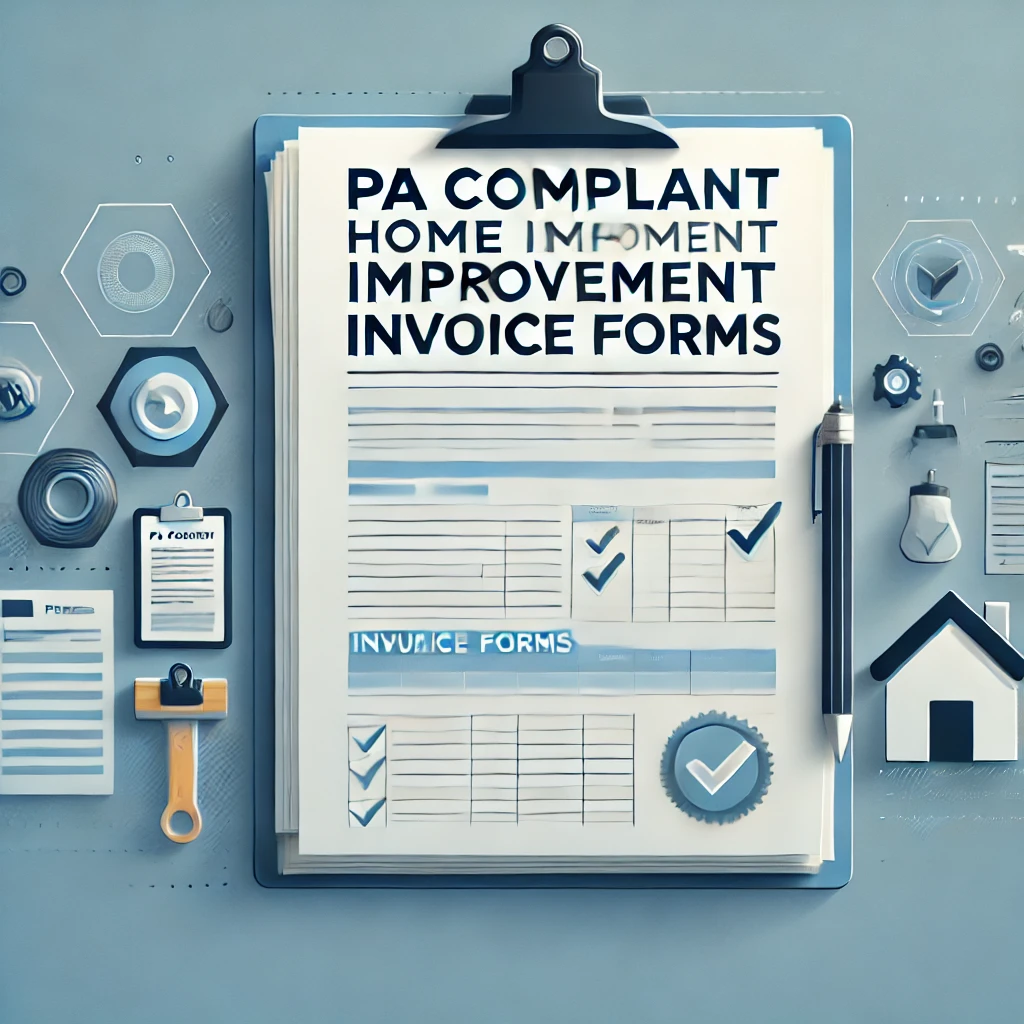Understanding PA Compliant Home Improvement Invoice Forms
When discussing the subject of PA compliant home improvement invoice forms, one cannot underestimate the importance of adherence to Pennsylvania’s unique statutory requirements for home improvement contractors. This article aims to provide a meticulous analysis of these specialized forms, exploring their legal relevance, intricacies, and the pivotal role they play in the realm of contracting work.
The Essential Role of Home Improvement Contracts in Pennsylvania
The Pennsylvania Home Improvement Consumer Protection Act (HICPA), enacted to safeguard consumers, mandates strict guidelines regarding written contracts for any home improvement projects exceeding $500. This legislation underscores the need for transparency, accuracy, and thorough documentation through a proper invoicing system. Contractors failing to comply with these standards may face legal consequences, including the voiding of contracts or financial penalties.
What Are PA Compliant Home Improvement Invoice Forms?
A PA compliant home improvement invoice form is a document that satisfies the requirements set forth under Pennsylvania’s legal framework for home improvement projects. These forms are not merely templates for billing; they encapsulate the contractual obligations between the contractor and the homeowner, detailing specifics about the project, pricing, and the services rendered. They ensure the project aligns with both state law and consumer expectations.
Key Components of PA Compliant Home Improvement Invoice Forms
To meet the stringent standards of the HICPA, a compliant invoice form must include several essential elements. Each of these elements plays a critical role in fortifying the legitimacy of the contractor-client relationship, minimizing the risk of disputes, and ensuring full transparency. The components include:
1. Identification of the Contractor and Consumer:
Every invoice must prominently feature the contractor’s business name, address, telephone number, and HIC registration number. The client’s details should also be clearly listed to ensure mutual identification.
2. Detailed Description of Work:
The description must be comprehensive, encapsulating every aspect of the work performed. Ambiguities are not permissible under PA law, as they could render the contract unenforceable.
3. Total Contract Price:
A clearly itemized breakdown of all costs involved, including materials, labor, and applicable taxes, is imperative. This ensures that both parties understand the financial expectations before the project’s commencement.
4. Payment Terms:
A detailed explanation of the payment schedule, including deposits, installments, and final payment, is crucial. This component aids in preventing misunderstandings and aligns expectations regarding payment timelines.
5. Estimated Start and Completion Dates:
These dates must be indicated to provide a clear timeframe for project execution. It is a safeguard against unreasonably prolonged projects, ensuring that contractors remain accountable for delays.
6. Signatures of Both Parties:
The invoice form must include the signatures of both the contractor and the client. This serves as evidence that both parties consent to the terms outlined within the document.
Legal Significance of PA Compliant Home Improvement Invoice Forms
The legal significance of these invoice forms is profound. By meticulously adhering to the outlined requirements, contractors can shield themselves from potential legal disputes. Pennsylvania’s consumer protection laws aim to prevent deception and misinformation, ensuring that homeowners fully understand their contractual obligations. A form that lacks any of the requisite details may be rendered invalid, which could result in the contractor being unable to collect payment or facing lawsuits.

How Do PA Compliant Home Improvement Invoice Forms Protect Homeowners?
For homeowners, these forms represent a layer of protection against fraudulent practices and substandard work. Pennsylvania’s laws are crafted with a consumer-centric focus, emphasizing transparency and fairness in all home improvement dealings. A PA compliant invoice form guarantees that homeowners are well-informed about the scope and cost of their projects, thus preventing unexpected charges or unanticipated work variations.
The Consequences of Non-Compliance for Contractors
Failure to adhere to the guidelines for PA compliant home improvement invoice forms could spell disaster for contractors. If a contractor fails to produce a written contract for work valued over $500, the HICPA allows homeowners to nullify the agreement. In such instances, contractors may be barred from collecting any outstanding payments, even if the work was completed satisfactorily. The reputational damage associated with non-compliance could also prove devastating for a contracting business, undermining client trust and future opportunities.
Crafting a PA Compliant Home Improvement Invoice Form: Step-by-Step
To design a robust invoice form that meets Pennsylvania’s legal standards, contractors should follow a meticulous approach:
Step 1: Gather Accurate Contractor Information
The form must commence with the contractor’s precise business information, as mandated by the HICPA.
Step 2: Outline Scope of Work in Detail
An exhaustive description of services to be provided ensures clarity. This should include all materials, labor, and any subcontracting that may occur.
Step 3: Define the Total Cost
Providing an itemized total is not merely a formality; it helps preempt financial disagreements. Transparency in pricing builds trust with clients.
Step 4: Specify Payment Milestones
Clear delineation of when payments are due, particularly for larger projects involving multiple phases, can streamline the payment process.
Step 5: Ensure Proper Signatures
The signatures of the homeowner and the contractor are a legal necessity, signaling agreement to the terms set forth.
Common Pitfalls When Drafting PA Compliant Home Improvement Invoice Forms
Despite the detailed nature of the HICPA, contractors often make critical errors when drafting these forms. Some common mistakes include:
Omitting Key Information:
Failing to include essential details like the contractor’s HIC number or leaving the project scope ambiguous can invalidate the form.
Using Generic Templates:
Many contractors opt for generic invoice templates found online, which may not meet Pennsylvania’s specific requirements. This approach can result in non-compliance.
Improperly Stated Payment Terms:
Vague payment terms can lead to disagreements and confusion. For example, failing to outline when the final payment is due could result in delayed payments or even non-payment.
Why Should Contractors Prioritize Compliance?
For contractors, prioritizing the creation of PA compliant home improvement invoice forms is not merely a matter of legal obligation—it is a strategic business decision. Compliance ensures that contractual relationships with clients are grounded in mutual understanding and transparency. This not only shields contractors from potential litigation but also enhances their reputation as reliable professionals.
Evolution of Home Improvement Contracts in Pennsylvania
The landscape of home improvement contracting in Pennsylvania has evolved significantly over the years, with increased emphasis on consumer protection. Historically, verbal agreements sufficed for many small-scale projects, but growing complexities and consumer complaints necessitated the introduction of HICPA. This shift reflects a broader trend towards greater accountability and standardization in contracting practices.
Comparative Analysis: PA Compliant Forms Versus Standard Invoices
A key distinction between PA compliant home improvement invoice forms and standard invoices lies in the legal precision and detail required. While standard invoices may focus on summarizing the services provided and costs, PA compliant forms require comprehensive documentation that includes legal clauses, detailed service descriptions, and consumer rights. This meticulous attention to detail is what ensures these forms hold up under legal scrutiny.
Practical Tips for Drafting PA Compliant Home Improvement Invoice Forms
Leverage Professional Legal Assistance:
Given the legal intricacies of Pennsylvania’s home improvement laws, consulting with an attorney can help ensure the form meets all required standards.
Utilize State-Approved Templates:
Some contractors may benefit from using templates provided by local trade associations or industry groups. These templates are often designed to align with Pennsylvania’s legal requirements.
Regularly Update Forms:
Laws and regulations evolve over time. Ensuring that invoice forms are regularly updated can prevent inadvertent non-compliance.
The Role of PA Compliant Home Improvement Invoice Forms in Dispute Resolution
When disputes arise between contractors and clients, these forms serve as critical evidence. Whether the disagreement pertains to payment terms, project scope, or quality of work, the detailed nature of the invoice form can clarify the intentions and agreements of both parties. In many cases, well-drafted forms have helped contractors successfully defend their rights in court.



